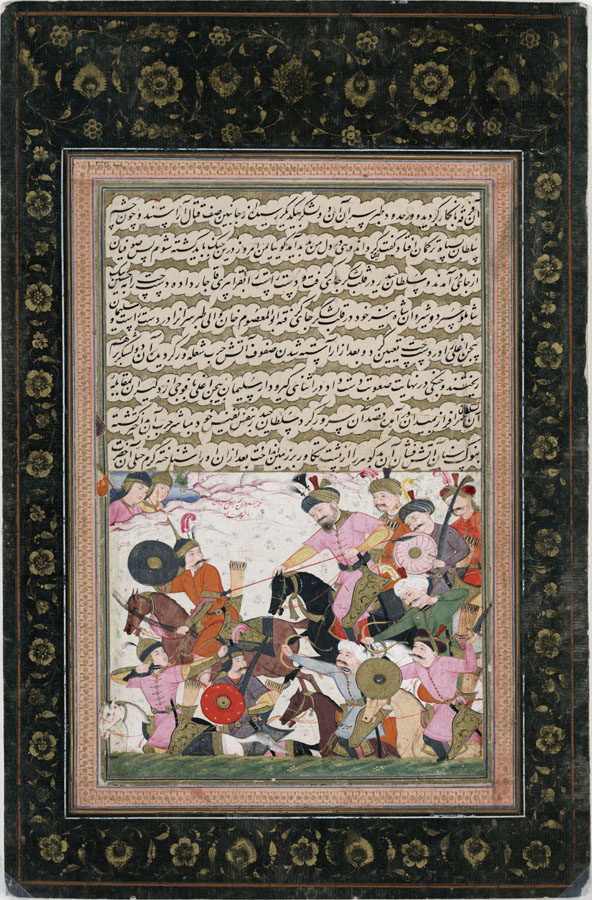Location: Free Library of Philadelphia, Philadelphia Pa., Lewis 33 P106.
Mount: black with gold 35.8 x 23.5 cm; salmon colored collar.
Written surface: 23.5 x 15.0 cm;
Painting: 12.4 x 15.0 cm.
Text references: J.K., p.45 line 6 to p.46 line 2.
See Savory, SA_1979, pp. 32-33 for this event in the History of Shah ʿĀbbās
Date of this event: 893/1488.
Sultan Ḥeydar, father of Esmāʿil, had assembled an army and was marching northward towards Circassia. Širvānšāh (Forroḵyasār) b. Sultan Ḵalil, the Turkman ruler of Shirvan, thought that Ḥeydar’s thrust was directed against his territory, and commenced hostilities. Soon realizing his forces were no match for the Safavids, Širvānšāh requested assistance from Sultan Yaʿqub, the Turkman ruler of Tabriz, who promptly dispatched Soleymān Biǰān-oḡlu with 4,000 troops. The two armies drew up for battle near Ṭabarsarān. The order of battle had Širvānšāh positioned at the center of the Turkman forces, Abuʿl Masʿum Khan on his right, and Soleymān Biǰān-oḡlu on his left. The Safavid forces included Qarā Piri Qājār on the right of Sultan Ḥeydar, and on his left Ḥoseyn Beg Lala. The battle raged with intensity, and at its height Soleymān led a small force in a direct attack against Ḥeydar, who engaged him in personal combat, and unhorsed him with his lance. The painting depicts precisely that moment in the battle, with Ḥeydar, the most prominent figure in the upper center, thrusting a lance at his adversary. As Soleymān lay on the ground, Ḥeydar recognized him, spared his life, and allowed him to remount. Ḥeydar’s companions inquired astonishingly about this generosity, to which Ḥeydar replied that Soleymāns’ life span had not yet come to an end, whereas his would be terminated in this battle. Fulfilling the premonition, later in the battle Ḥeydar received a mortal wound from an arrow. Disheartened, the Safavids gave up the struggle, which then turned against them.
The page is divided almost exactly in half: the upper portion is comprised of eight lines of single column text with gilt interlinear decoration that compresses the illustration below. The composition, although competent, is not highly original. The Safavid forces, Sultan Ḥeydar and six ǧāzis, are tightly compacted on the right side. Armed with swords, lances, and bows, they pursue the Turkmen, Soleymān Biǰān-oḡlu and two companions, toward the left. Soleymān and another defend themselves with sword and shield, while the third returns fire with a bow and arrow. The battle takes place on a river bank with the figures in the foreground partially immersed in water; the bank rises behind them, and in the upper left from behind a ridge, two helmetted heads appear. Two of the combatants, Sultan Ḥeydar and Biǰān-oḡlu, are obvious from their actions. The remaining participants are not readily identifiable with the exception of one in the lower foreground, on whom is inscribed Mamyaš Ḵān, a personage of uncertain identity. The painting is neither signed by the artist nor dated, but the style makes an attribution to Moʿin, perhaps with assistance, quite plausible.
Painting references:
Anderson Gallery, November 30 - December 1, 1923, Lot 287.
Sims, BrMus_1997, p.1
Sims, Safavid_2002, fig.10.1 (ill. in black and white).
Provenence: Formerly in the John Fredrick Lewis Collection. A note on the verso indicates that it was purchased from Reżā Khan Monif at an Anderson Company sale on 25 November 1923 [sic -- sale was 30 November - 1 December 1923]. Also written on the verso are the numerals "287", which corresponds to the description for lot 287 in the same sale. Sale price was $42.50.
Photo used by permission of the Rare Book Department, Free Lbrary of Philadlphia.
Robert Eng
Last Updated: January 9, 2013 | Originally published: August 1, 2011
